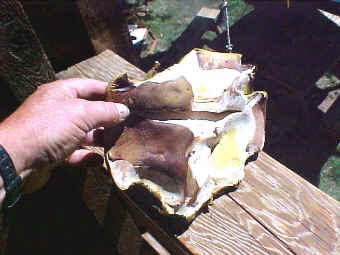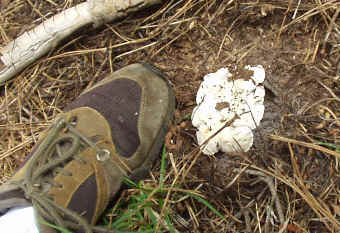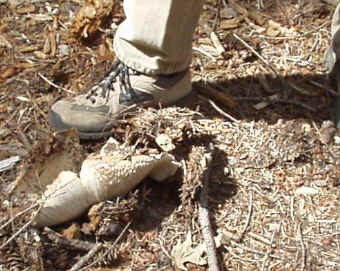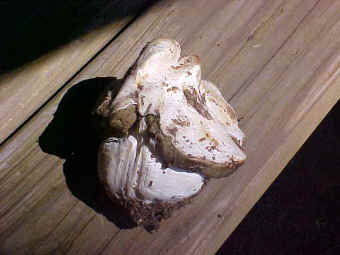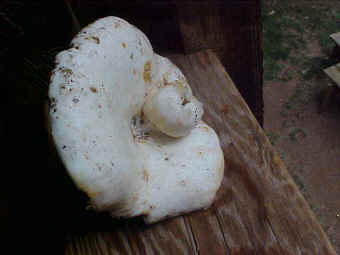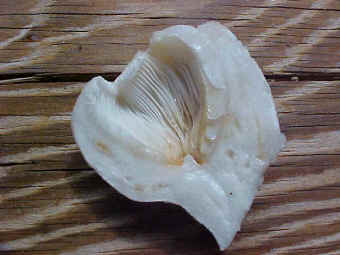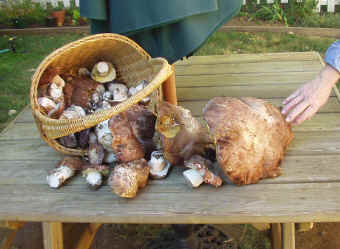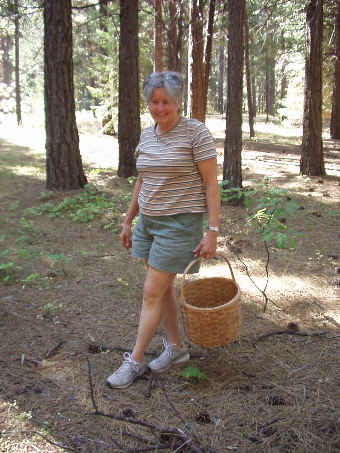|
Thirteenth Issue,
October 2003
This season following the summer was much better than we could have expected, probably because we actually had about an inch of rain around early August. I found very many King and Queen Boletes (Boletus edulis and B. aereus) at the same spots that I had found them in 1998, plus more than a few Shrimp Russulas (Russula xerampelina), and found several new spots for finding those boletes and White Chanterelles. I helped host a foray at Yuba Pass which turned out to VERY successful, where I found or saw two Matsutakes (Armillaria ponderosa) and one Golden Chanterelle (Cantharellus formosus), two species that I have not yet seen in the Sierras since we moved here. I also added a few new mushrooms to my list of finds, something that always brings me satisfaction to report. And I sampled a few species for the first time, and all with no ill affects. Findings, August 7 to October 19th (top) Thursday, August 7: Based on the recent report of the boletes appearing after the last rains, I went to one of my Boletus edulis spots, where I had found several of them in the fall of 1997:, A Most Memorable Hunt. I didn't see any up yet, but did find some clumps of what should be the Polyporus badius. They averaged about 6" in diameter, and each had a very black stem. I took a few pictures of them which can be seen at MVC-506F.JPG and MVC-507F.JPG Later today, I went to an area above town (4400 ft) to check out a few of my White Chanterelle spots. The first chanterelle I found by digging and was pretty small. The next batch I found were under almost imperceptible mounds, were a bit larger, but all had the same lack of moisture as the ones I found in the same area September 7 of last year, mush10.htm. I hope the little bit of rain we got recently will encourage them to continue to grow. I then went to a ranch nearby and picked a good-sized batch of Marasmius oreades from their huge big lawn. Not a bad haul! Thursday, August 28: Because patience is not really one of my virtues, I decided to recheck some of my White Chanterelle spots (at 4400ft.), mainly to see how much some had grown in 5 days. I had left a few small ones to make a check later. The ones I had reburied didn't seem to grow very much, but as I rechecked the other areas again, I started finding large ones. A few were in spots I had only checked briefly because of the lack of moisture. In these and the other spots, there were several fairly large ones. I guess the recent rains DID do some good. This time the mounds WERE perceptible. A few had even broken ground and were waiting for me. So I brought home a nice batch, about 2 lbs. Cecelia said I looked like a happy camper. Later, when I was cleaning the dirt off of them, I found that I had somehow picked up a Gastroboletus subalpinus, or Gastroid King Bolete. Friday, August 29: Encouraged by my finding the larger White Chanterelles yesterday, I decided to recheck a few of my old Fall King Bolete spots closer to town (Greenville, 3600 ft.). I parked the truck next to where I had found some Queen Boletes during the first weeks of October, 1998 (mush2.htm) and noticed two large, chomped-off mushroom stumps close to the road. On closer inspection, I saw that they were indeed from a pair of the large Boletus edulis. I anxiously started looking around the immediate area and found a part of a cap next to another hole. I searched several times around the whole area, finding more holes with pieces of King Boletes in them, collecting those as I walked. Finally, I found one that was almost whole.
This is a week earlier than I found them in 1998. All the pieces I found looked like they were from pretty good-sized boletes. I also found a few mounds with Russula brevipes under them, and two more mounds with dark red-capped Russulas, one of which I took home to identify. When I got home, I cleaned what I gathered of the boletes, cooking up the stems and putting the one cap I found into the drier, because the cap was pretty soft. If I had only checked the same place a few days ago! The cooked stems were crunchy but tasty. I then sniffed the gills of the dark red-capped Russula and noticed a faint shrimp odor. The stem and gills were staining brown slightly, the flesh in the stem was beginning to get spongy, and the taste was mild so I finally decided it must be the Shrimp Russula, something else I also hadn't found here since 1998. So I sliced and cooked up the cap in some butter and sampled a few bites. Delicious! I guess I should start checking my spots more often now! Saturday, August 31: Today we went up towards Lake Almanor to see if we could find any King Boletes. As soon as we got out of the truck, we found several huge brown boletes, the sight of which made both our hearts beat a bit faster. On closer inspection though, they turned out to have red pores and yellow flesh that blued when cut. Instead of the expected edulis, they turned out to be the poisonous Boletus pulcherrimus, and this was the first time I had bothered to key them out. We saw lots of them in our wanderings, but little else. Closer to home we did find some each of the Lactarius with the orange latex and red latex, the Lactarius deliciosus and L. rubrilacteus (locally called the Sanguines). I have a friend here in town that loves them. Sunday, August 31: This afternoon, with Cecelia along with me, we decided to recheck my boletus spots after 2 days. We actually found a Boletus edulis button under a small mound, which encourages me to continue checking the same spots for a while, but just to wait a few more days next time. But we also found a nice patch of the Shrimp Russula. These were young and didn't have much of an odor, but looked exactly like the ones I had picked on Friday. I was worried about misidentifying them because the stems were all white, the caps dark red, but they bruised brown when touched and had a mild taste. I just cooked them all up and tasted a few. The taste and texture was the same as Friday's group, and I didn't get sick.
Saturday and Sunday, September 6 and 7: This weekend we had a couple from the Bay Area (Alex and Barry, both new members of the MSSF) come up to Greenville to camp and to look for mushrooms with us. I think we all did pretty good in spite of the dry conditions. I was pretty pessimistic before they got here because of the lack of moisture, but pleasantly surprised by the finds. Between the four of us, we found:
plus a few I forgot. After the first day, Alex and I spent about an hour cleaning the first batch of Chanterelles. Because many of the chanterelles had worked so hard to push through the hard dirt, they were packed with it. We used scrub brushes, knives, and plenty of water, as they were VERY firm, probably due to the lack of available moisture. On Sunday, we returned to the same general area and mostly found more Chanterelles, Gastroid King Boletes, and more Schweinitzii. Some of the chanterelles were right next to where we had picked some the day before. Alex likes to use various mushrooms for dyes, so she was very happy with today's find. I later cooked up some of the Gastroid King Boletes, and thought the taste of the stems to be strong but edulis-like. I also cooked up the Albatrellus flettii, and found the taste indistinctive, but the texture similar to the chanterelles we just picked, or a very young edulis. It is worth trying, if you can get enough if the flesh that is free of inhabitants. It was a successful and pleasant weekend, and Cecelia and I both enjoyed making two new friends. Monday, September 8: Cecelia and I went back to the Chanterelle area at about 3 p.m. today, because we wanted to continue down the road past where we had stopped on Sunday. On the way to the area, we saw with some friends and invited them to come join us. As we left the place where we parked the cars, we all walked very slowly so I could check the same areas out AGAIN. Before we got to the place where we had stopped Sunday, we had almost filled our basket. One of our friends got pretty good at spotting the mounds. We finally filled the basket almost to the top by the time we got back to the truck. Another nice way to end the day! Tuesday, September 9: Today, I went back to check some new areas, and right when I got out of the truck, I immediately found 3 mounds, each containing Hydnum imbricatum (AKA Dentinum imbricatum, Sarcondon imbricatum, and Sarcondon imbricatus).
I didn't find more Chanterelles until I got close to the same old areas again. This time I left before I got very many. They are too hard to clean! I also found this unusual Russula brevipes with a smaller one growing out of the top. What seemed the most unusual was the way the smaller one was growing, actually backwards. It looked like a small vase with the gills on the inside of the vase. After I got home and cleaned all the chanterelles, I decided to recheck the spot where we had left some Boletus aereus button on Saturday, when Alex and Barry were here. This area is at about 3600 ft. The buttons we had reburied were almost ready to pick, but I noticed several more small ones near by. This meant that I just had to recheck the whole area, and in doing so, started finding more buttons. Then I started finding larger ones, and the largest ones so far being right along side the road where I parked my truck. With these, I filled my basket to about half full. Then I went to the other area where I had first found many King Boletes in 1997, and found LOTS more of the B. aereus. Several very large ones were in a small depression, like a dug-out hole. Here I found the largest I had ever found this year, about 10" in diameter. By now my basket was overfull and very heavy, so I took it back to the truck. I then walked back to where I had found most of them, and on the other side of a clearing, I saw the biggest mound I had ever seen, and under that was the biggest Boletus aereus I had ever seen. Some of these may have been the edulis, but most had that whitish bloom. I then unsuccessfully checked out a few other areas, and finally went to an area where I usually find Chanterelles, closer to town. Here I found three CLEAN White Chanterelles. Thursday, September 11: Cecelia
and I went to an RV resort area at 5200ft. today to look for Boletus
edulis, took some pictures, and brought back some samples. You can see
some of the pictures I took at: There were indeed many to see on both sides of the dirt road, and we found several other species, including some Shrimp Russulas and fresh Dyer's Polypore. Most were pretty old but we filled our basket with younger ones that looked good enough to take home. We had been told about them a week ago, but couldn't go until today. I do wish we had gone earlier. We also had a great lunch at the restaurant on the lake, splitting a very large pastrami sandwich and drinking a tall glass of tapped Sierra Nevada Pale Ale. We may return soon, as we found a few very small buttons. When I got home, I rechecked my local White Chanterelle spot, and found about a dozen more, mostly in areas that I hadn't checked before. Friday, September 12: This morning I got an ATV ride with a friend who wanted me to look at some strange greenish mushrooms he saw in an almost inaccessible area above town. Since this was my first time on an ATV, it took a bit of time to get to the site. When we finally got there, I could tell at a glance that they were the Dead Man's Foot, or Pisolithus tinctorius, right in the middle of the road. We gathered about 10 lbs for Alex. Later, I went back to check my local boletus spot, as it had been two days. I found several nice-sized Queen Boletes, but this time I also found some King Boletus, several small edulis buttons, and more Shrimp Russulas. These I think I will dry for later. Most of the boletes were found right on the side of the road where I hadn't checked recently. I guess the season isn't over yet! Sunday, September 14: Today Cecelia and I took a bike ride along the bike trail near Lake Almanor. We saw lots of mushroom mounds, but those we checked were mostly infested with Russula brevipes. We eventually found a large Red-capped Butter Bolete (Boletus regius), right next to where I found a partially red-pored Boletus haematinus two days earlier, and a few Suillus, really not much near the lake yet. Basically, the difference between the regius and the haematinus seems to be the red pores when mature, so I left the regius where I found it. I have better boletes to pick locally anyway. On the way back, I thought I'd show Cecelia some of the places where I had marked a few boletus buttons on Friday, and to check how big they got in two days. Most were by now a good size, and as we checked
around, you guessed it, we saw lots more of the Boletus aereus and B.
edulis; some were huge, some seemed to be attached to the base of trees,
some were growing out of the Only a few of the B. aereus looked like a deer had sampled a small taste but had left the rest. Because I didn't have my knife and basket, I went home, called a few friends to get their help in the harvest, and because they weren't home, I had to go back and do all it by myself. Sob! So I got far too many, and only the very largest had any worms. Some of the small ones had centipedes burrowing into the lower base of the stalks which was easy to trim off. I also found a few of the edible Shrimp Russulas and have put them into the drier. The larger boletes I sliced and are now in the drier too, and the rest I added to my big bag of boletes. The pore mass of the larger ones I took back and planted in the forest. Someone pinch me! I think I am dreaming. I think I will just have to let the worms have the rest of them for a few days. Tuesday, September 16: This morning I went back to my local boletus spot to check the crop, as I was expecting a few friends to help me pick them later that evening. I saw lots of mounds and a few pretty large Boletus aereus. I left them for the evening. In the afternoon, I went up to my Chanterelle spot to check it out, but only found a few pretty poor chanterelle specimens. But what I did find in one area, was a small Boletus aereus button, and evidence of a larger one probably eaten by a deer. I continued looking for Chanterelles, found none, and then went back to the same spot again. I found another aereus button and a medium-sized whole one. All were found under or next to a bush. I also saw many Grisettes. It looks like the boletus season has started at 4400 ft. That evening with my friends, we each filled our baskets/bags, with plenty large to medium-sized boletes, both aereus and edulis. We even found a few fresh Shrimp Russulas. I told them they should come back daily to recheck the spots again. And I ordered another drier today. Wednesday, September 17: For an experiment, I went right back to the same spots I picked yesterday and filled my basket again with both King and Queen Boletes. Some were pretty large, so I suspect I probably just missed seeing them on Tuesday. I also picked a few more Shrimp Russulas I just can't seem to dry them fast enough! Thursday, September 18: We continue to find both B. edulis and B. aereus daily around Greenville at 3600 ft, and more recently at 4400 ft. There always seems to be a patch of the Shrimp Russulas nearby. The White Chanterelles seemed to have slowed down, but some of those I found lately contain much more moisture than the ones we had found earlier, so I suspect they will still be coming up for a spell. I would suspect that all the productive boletus areas would be worth checking almost daily, and then one could concentrate on finding the smaller bumps with the younger specimens. We continue to see lots of Grisettes (Amanita vaginata) coming up, a few fresh Gastroboletus, both yellow and tan Russulas, too many Russula brevipes, some Lyophyllum decastes, probably a Lactarius volemus (I didn't taste it), Scaly Chanterelles, and lots of various colored Rhizopogons, all in spite of the dry duff. The cooler nights seem to help keep most of them pretty fresh. What a difference a small bit of early fall rain made! Saturday, September 20: Today we went up to an area above Chester, at about 6000 ft. to see what we could find, mushroom-wise. We didn't see very much, but I collected one Hydnum imbricatum, and a few Scaly Chanterelles to experiment with later. We then continued all the way to the Guernsey Creek Campground, and only found a few more Scaly Chanterelles (besides the omnipresent Russula brevipes). These were the weird white Scaly Chanterelles that looked like they had just exploded. Here is a picture of one that I took a while back: 80491_24a.JPG. I collected these and then went towards home to recheck my boletus spots. As usual, we found lots, just like we have been finding every day, plus more of the Shrimp Russulas. When I got home, I cooked up the Scaly Chanterelles, and I believe I had two species, the orange colored Gomphus bonari, and the white colored G. kauffmanii, and both had white flesh. The taste when fresh was mild, but I did notice a slight sour aftertaste with the cooked kauffmanii. Both were pretty dry like the White Chanterelles I have been finding lately, and kind of crunchy. I didn't get sick from eating a modest portion of either, so I guess I am not one of those who might be adversely affected by consuming them. But I don't think I would bother to collect them again, even though they seemed to be edible to me. Like Larry Stickney says, why bother with questionable mushrooms when you have so many good edibles around? Sunday, September 21: We went on a short hunt today to check out our Chanterelle spot at 4400 ft. and to see if we might see anymore boletuses (boleti?). We did find more boletes, both B. edulis and aereus, more Shrimp Russulas, lots of the ubiquitous Russula brevipes, many Grisettes, and a few White Chanterelles. I also found a very large Scaly Chanterelle, and this one was a Gomphus floccosus (orange with creamy yellow-colored flesh) so I took it home for a taste. It had a bit better texture than the others I had tried (G. bonari and G. kauffmanii), but still had that slight sour aftertaste both fresh and cooked, but less after being well-cooked. I didn't eat very much because I wasn't fond of the aftertaste, but neither did I have any adverse reactions. I think I will leave the rest of these Scaly Chanterelles to admire in the forest.
Tuesday, September 23: Today a new friend from Concow, who long ago found out about us via this web site, came up to pick mushrooms with us. Cecelia stayed home, but between the two of us, she (our guest) and I did pretty good in less than 3 hours of walking. When she left, she was able to bring home with her over 5 lbs of Shrimp Russulas, about twice that amount the same for King and Queen Boletes, an ample supply of White Chanterelles, and a few other species to taste and test for edibility, which included the Russula brevipes var. acrior (green-tinged R. brevipes), the all-white Lepiota naucina (Woman on a Motorcycle), the orange Gomphus floccosus (Scaly Chanterelle), and a few Gastroboletus subalpinus (Gastroid King Bolete). She also took home a large Entoloma to see if she could key it out to species. We did much better than I suspected we would and even discovered a few new chanterelle spots. I think she had a good time. Soon after she left this afternoon, I took some samples of the best edibles that we found earlier (Kings, Queens, Shrimps, Chanterelles) to the young man who earlier had told me about a spot where he had seen some big brown mushrooms, at about 5000 ft. I also asked him for more directions to the spot and went up in that direction. Somewhere along the way I took a wrong turn and ended up about 3 miles down the road from where I was headed. Finally got close to the spot he described. It was a beautiful long valley oddly enough named Long Valley. At least I got to traverse roads I had only seen before from the other ends and had always wondered about. The only thing I found in the short time I was up there was a patch of sun-bleached Amanita muscaria. But on the way home, I found lots more of the Shrimp Russulas along the side of the lower paved part the main road, brought them home, and cooked them all in a bit of olive oil and butter. This catch included a wide range of colors: yellow, violet, pink, red, and combinations thereof. When I found them, they all had dirt and debris still stuck to the caps, softer-than-normal-for-a-Russula stems, turned brown when handled, and had the characteristic shrimp-like odor. I also found some Cortinarius among the same group that appeared to be mimics of the R. xerampelina, with yellow and violet caps. I have never seen them like this before. I thought they were the same as the rest until I saw the gills and stem. I sent a dried sample to someone who was interested in looking at them. Wednesday, October 1: It
seems like the season for mushrooms in the two spots I have been checking, is
about to end. But today I was able to find about a dozen un-fresh white
chanterelles, more Gastroid King Boletes, more Shrimp Russulas, one too-old
Boletus edulis, plus the usual Russulas, and an interesting one of which I am
trying to get It developed entirely under ground, is all-while, has non-staining, firm flesh, shaggy scales on top, close mostly free and smooth, not serrated, gills, a stem that is larger below and then tapers to a point, a trace of a veil on the stem, and no vulva. The scales on the top make it look almost like an all-white Lepiota rachodes. PA010001.JPG top view PA010002.JPG side view MVC-665AF.JPG close-up of gill attachment Even if I assume that the spores are white, it stumps me so far. Any ideas? I also ate a portion of a gastroid boletus that had more fresh flesh in the stem than usual, and found it to be very delicious, almost sweet. Monday, October 6: This morning I went up towards my chanterelle spots to look for another sample of the mysterious amanita and to take some pictures of the Pholiotas I had seen and picked samples of yesterday. Shortly after taking the pictures, I found 2 young samples of what look like the same Amanitas that I had found earlier, several White Chanterelles, and a few fresh Gastroid King Boletes. I also saw several large Cortinarius, as well as several different Russulas. When I got home I looked at the spores for the Pholiotas under the microscope and decided the closest match, because of the smaller spore sizes, (6 - 8 x 3 - 4 microns) was a P. limonella (= P. squarroso-adiposa). These were dry when mature, kind of sticky when very young, and were growing up the side of a dying conifer. This time I cooked up all of the gastroid boletes, pore tubes included, and thought that the taste of the pore tubes to be even better than the stem and cap flesh. So if you ever find any fresh ones without too many worms, you might want to try a taste. It seems that they are as popular with the worms as the regular fall King Boletes. I don't think I will try to taste any of the Pholiotas at this time. Saturday and Sunday, October 11 and 12: Here is the link to the report, pictures, and specie list from the Yuba Pass foray that we co-hosted on this weekend: yuba-03.htm Sunday, October 19: Except for regularly watered areas, I'd say that the mushroom season is essentially over in the Northern Sierras, at least between 3600 and 4400 ft., unless we get some rain soon. I did see the recurring large patch of Lyophyllum decastes again in a friend's yard earlier this week, but haven't harvested any yet. But on Sunday the 19th, Sherri and Peter (two MSSF members from Chico that we met on the Yuba Pass Foray), came to our house to pick up a microscope that I sold Peter and to possibly look for some mushrooms. Our first trip out was to the local cemetery where we found about 15 different species. We had to end the hunt because of a disturbed wasp's nest and resultant sting. However, we found lots of different-looking Honey Mushrooms, a few Lactarius, at least 3 different species of the Waxy Caps, a few Russula, several different LBMs (some with white and some with brown spores), a Gemmed Puffball or two, a few Leucopaxillus gentianeus (a new species for me), at least two species of Suillus, a few all-white Hygrophorus, plus many that I have forgotten. The few that I can remember are:
So remember check your fall lawns! Monday, November 17, 2003: It has warmed up and dried out enough for me to want to go out and check a few of my mushroom spots up here in Greenville. At 4400 ft, I found about 5 different species, the notable one being the White Chanterelle (Cantharellus subalbidus). Most of the chanterelles I found at that elevation were a bit water-logged, but the few I found later at 3600 ft. were larger and not water-logged at all. This is the first time I have even looked for them at this time of year, but recent rains and the lack of snow encourages me to want to look again tomorrow. They still were hard to clean. Follow-up: I didn't find any additional chanterelles in my later searches. Wednesday, November 19: I heard that we might be getting snow tomorrow in the Sierras down to 2000ft., so I went up towards Lake Almanor to check my two faithful Shaggy Mane (Coprinus comatus) spots before they were under snow. As soon as I parked my truck at the first spot, I could see a few clusters already above the ground. These were pretty large specimens and already showing their dark pleated skirts. The rest were perfect. Between the first spot and the second, which is along the Highway that parallels the lake, I collected over 4 pounds. This time I cleaned them off before I put them in my basket. If it doesn't snow tomorrow, I may go back, as there still were many clumps and bumps left. Saturday, November 23: It got down to about 15 F last night in the Sierras, but I went anyway up to my Shaggy Mane spots near Lake Almanor to see if I could dig up some still-fresh specimens. All except those above ground were frozen solid, and those that were above ground had already begun to thaw and felt pretty mushy. I figured that the texture wasn't that firm for Shaggy Manes anyway, and even after being frozen, then cleaned and cooked immediately, they would probably just be a bit softer. So I collected a small batch of the small, frozen ones and gave them to some friends to try. I had been promised some elk in trade for some Shaggy Manes. They said that after cooking them, they tasted very good. We enjoyed the elk too.. This kind of extends the picking season up here a bit. Take your CO2? (top) I saw the following comment in an August email posting sent by Norman Andresen, and thought that the follow-up information might be useful to some of you:
I wondered what it meant by "take your CO2", but thought it was just a typo until I saw a subsequent posting by Henry Shaw (and others), in response to a question by Lynn Marsh:
From Henry Shaw:
From Norm Andresen:
And the following from Connie Green:
But it's sure worth the try if it helps any! Featured Mushroom, the Hawk's Wing (Hydnum imbricatus, et al (top) This year we found several pounds of the Hydnum imbricatum (AKA Dentinum imbricatum, Sarcondon imbricatum, and Sarcondon imbricatus), a very striking mushroom to find. We cooked up one for the Yuba Pass Foray, and everyone that sampled some seemed to think it had a nice taste. All except the one I cooked have been dried to give to someone who uses them for making dyes (colors from brown to purple). For a direct link for this mushroom on the Mykoweb site, complete with pictures, go to: http://www.mykoweb.com/CAF/species/Sarcodon_imbricatus.html |

